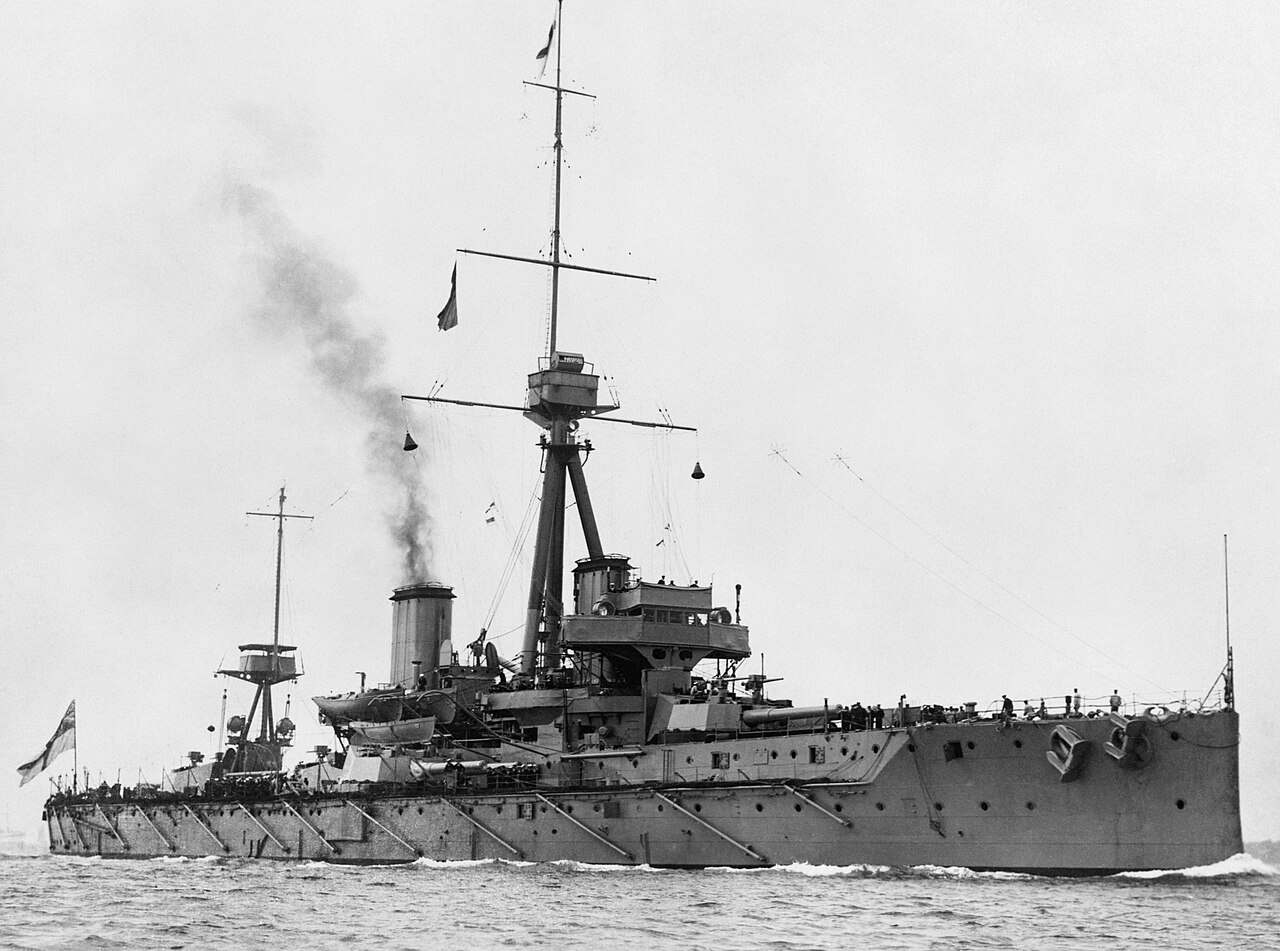HMS Dreadnought, launched in 1906, revolutionized naval warfare with its all-big-gun design and steam turbine propulsion, setting a new standard for battleships worldwide.

In March 1915, Dreadnought achieved a unique distinction by becoming the only battleship in history to sink a submarine, the German U-29, by ramming it.
Inception of HMS Dreadnought
At the dawn of the 20th century, the naval arms race was intensifying, particularly between the world’s foremost naval powers, Britain and Germany.
This period was characterized by rapid advancements in naval technology, including armor, propulsion, and armament.
It was within this context of innovation and escalating tension that the concept of a revolutionary new class of battleship began to take shape in the British Admiralty.
The idea behind HMS Dreadnought was born out of a desire to maintain British naval supremacy.
At a time when nations strove to outdo each other in battleship design, Britain sought to leapfrog the incremental advancements of its rivals with a radical new approach.
The brainchild of Admiral Sir John “Jacky” Fisher, the First Sea Lord, Dreadnought was envisioned as a battleship that would render all existing battleships obsolete, embodying Fisher’s philosophy that “speed is armor.”

HMS Dreadnought just days after her keel was laid.
The construction of HMS Dreadnought was undertaken with a sense of urgency that reflected the Admiralty’s determination to assert its naval dominance.
Laid down in October 1905 at the Royal Navy’s dockyard in Portsmouth, the ship was completed at a breakneck pace, being launched in February 1906 and commissioned into the Royal Navy by December of the same year.
This rapid construction, achieved without sacrificing quality, was a testament to Britain’s industrial might and technological sophistication.
The launch of Dreadnought was a spectacle that captured the public’s imagination and signaled a new era in naval warfare.
The ship’s sleek profile, imposing armament, and the sheer power suggested by its steam turbines embodied the might of the British Empire at its zenith.
It was a clear statement of intent; Britain would not be surpassed at sea.
The commissioning of HMS Dreadnought had immediate and far-reaching implications for naval strategy and the global balance of power.
It effectively reset the naval arms race, as existing battleships were suddenly classified as “pre-dreadnoughts,” with countries rushing to design and build their own dreadnoughts in response.
The ship’s design influenced battleship construction for the next decade, until the advent of the aircraft carrier began to redefine naval power once again.
Revolutionary Design of HMS Dreadnought
HMS Dreadnought’s design and armament were revolutionary, embodying a radical departure from previous battleship concepts and setting a new standard for naval warfare.
This segment of the ship’s history focuses on the innovative aspects of its design, armament, and the resulting impact on global naval strategies.
The design of HMS Dreadnought was predicated on a simple yet transformative principle: to outgun and outrun any potential adversary.
This was achieved through a combination of advanced armament, propulsion technology, and strategic design choices that prioritized speed and firepower over the traditional balance of speed, armor, and armament.
All-Big-Gun Armament: HMS Dreadnought was equipped with ten 12-inch guns arranged in five twin gun turrets. This uniform, heavy-caliber armament allowed for longer-range engagements with unprecedented firepower.
The decision to standardize the main battery to a single caliber—eliminating the secondary battery of smaller guns typical of pre-dreadnought designs—meant that Dreadnought could deliver a more concentrated and devastating broadside at greater distances. This not only increased her lethality but also enhanced her ability to engage multiple targets effectively.
Turret Placement and Ship Layout: The strategic placement of Dreadnought’s turrets was another innovative aspect.
With three centerline turrets (one forward, one aft, and one amidships) and two wing turrets, Dreadnought could fire a full broadside utilizing all ten of her main guns.
 12 inch guns on board the ship. Note the 12 pounder guns mounted on the roof, these were for defence against torpedo boats.
12 inch guns on board the ship. Note the 12 pounder guns mounted on the roof, these were for defence against torpedo boats.
This was a significant improvement over the pre-dreadnought battleships, which could not bring all their guns to bear in a single broadside.
The layout maximized the ship’s offensive capabilities while simplifying aiming and fire control.
Steam Turbine Propulsion: HMS Dreadnought was the first battleship to be powered by steam turbines, a technology that provided significant advantages over the traditional reciprocating steam engines.
Developed by Charles Parsons, the turbine engines offered greater efficiency, reliability, and, most notably, a higher top speed.
At over 21 knots, Dreadnought was faster than any battleship of her time, allowing her to dictate the terms of engagement.
This speed, coupled with her formidable armament, made Dreadnought a hunter rather than the hunted, capable of outrunning any ship she couldn’t outfight.
Dimensions
The hull of HMS Dreadnought was designed with both speed and stability in mind, a reflection of the ship’s intended role as a fast battleship capable of both engaging the enemy at long ranges and evading return fire.
Measuring approximately 527 feet (160.6 meters) in length with a beam of 82 feet (25 meters), the ship’s large size facilitated the inclusion of advanced machinery and armament while providing ample space for crew accommodations.
Her draught of 29 feet (8.8 meters) allowed for a relatively low profile in the water, reducing her visibility to enemy forces.
The hull’s construction utilized high-quality steel, contributing to a displacement of about 18,110 tons under standard load.
The armor protection scheme of HMS Dreadnought was meticulously designed to withstand hits from the heavy guns of contemporary battleships.
The main belt armor was 11 inches (279 mm) thick, tapering to 4 inches (102 mm) towards the bow and stern, providing critical protection to the waterline and vital machinery spaces.
The main turrets and barbettes received up to 12 inches (305 mm) of armor, while the conning tower was protected by 11 inches (279 mm) of hardened steel.
This comprehensive armor layout ensured the ship’s survivability in the face of enemy fire, balancing the need for protection with the imperative of not overly burdening the ship’s displacement and speed.
Operational History
Launched in 1906 and commissioned into the Royal Navy in December of that year, HMS Dreadnought immediately became the flagship of the Home Fleet.
Its very existence was a powerful deterrent, embodying the Royal Navy’s technological and tactical supremacy.
 An imposing beast! HMS Dreadnought in harbour circa 1906-7.
An imposing beast! HMS Dreadnought in harbour circa 1906-7.
Despite its formidable capabilities, Dreadnought saw limited action during its operational life, most notably participating in the extensive patrolling and blockading efforts during World War I as part of Britain’s Grand Fleet.
HMS Dreadnought did not participate in the Battle of Jutland, which took place on May 31 to June 1, 1916.
At the outbreak of World War I, Dreadnought was the flagship of the 4th Battle Squadron of the Grand Fleet, based in Scapa Flow.
However, by the time of the Battle of Jutland, it had been reassigned.
In fact, although she was designed to fight battleships her most significant combat action occurred in March 1915, when it became the only battleship in history to sink a submarine, the German U-29, by ramming.
Sinking of U-29
The engagement between HMS Dreadnought and the German submarine U-29 on March 18, 1915, unfolded under the vast, grey expanse of the North Sea.
As the British Grand Fleet conducted its operations, the seascape was punctuated by the unexpected appearance of U-29, surfacing in close proximity to the dreadnought.
This act, necessitated by the submarine’s need to use its periscope for navigation and targeting, inadvertently exposed U-29 to the vigilant lookouts aboard the Dreadnought.
Commanded by Admiral Sir John Jellicoe, the British battleship was at the forefront of naval innovation and power. The moment the submarine’s silhouette breached the horizon, the Dreadnought’s crew sprang into action.
Admiral Jellicoe, recognizing the rare opportunity to eliminate a direct threat, ordered an immediate and aggressive maneuver.
The Dreadnought, leveraging its superior speed and maneuverability—a surprising attribute for a ship of its size—initiated a direct charge towards the U-29.
This decision to ram the submarine was both audacious and reflective of a time when naval tactics were still deeply influenced by principles of direct engagement and physical might.
 HMS Dreadnought during a refit in Portsmouth, 1916.
HMS Dreadnought during a refit in Portsmouth, 1916.
The moments leading up to the collision were tense, with the sea churning under the Dreadnought’s massive hull as it gained momentum.
Onboard U-29, Kapitänleutnant Otto Weddigen and his crew would have been acutely aware of their precarious situation.
Despite their submarine’s capabilities for underwater evasion, the suddenness of the encounter and the Dreadnought’s swift response left them with little time to react.
The submarine attempted evasive maneuvers, but the vast disparity in surface speed made the outcome inevitable.
The impact was catastrophic for U-29. The Dreadnought’s reinforced bow struck the submarine with such force that it cleaved the U-boat in half, sealing the fate of Weddigen and his crew in a matter of seconds.
The submarine sank rapidly, disappearing into the cold depths of the North Sea, taking with it all hands on board.
In the aftermath of the ramming, the Dreadnought emerged largely unscathed, a testament to its robust design and construction.
The sinking of U-29 by ramming was a rare feat in modern naval warfare, underscoring the unpredictable and multifaceted nature of combat at sea.
This engagement not only demonstrated the effective use of traditional tactics against newer forms of naval threats but also highlighted the inherent risks submariners faced when pitted against the might of a dreadnought.
The Fate of HMS Dreadnought
After the conclusion of World War I, HMS Dreadnought, the ship that had once revolutionized naval warfare, found itself overshadowed by the very advancements it had sparked.
The rapid pace of naval technology evolution during the war years, coupled with changing strategic imperatives, rendered many features of pre-war battleships less relevant.
As the world transitioned into a peacetime setting, the fate of HMS Dreadnought was sealed by both its obsolescence and the shifting dynamics of international naval policy.
In 1919, HMS Dreadnought was decommissioned from active service, marking the end of its operational life.
This step was reflective of the broader post-war realignment within the Royal Navy, which sought to modernize its fleet in response to new technological and strategic challenges, including the emergence of air power as a key factor in naval engagements.
 Firing her 12 inch guns during battle practise in 1914.
Firing her 12 inch guns during battle practise in 1914.
The ship’s decommissioning was followed by its sale for scrap in 1923, a common fate for many battleships of its era, as nations looked to reduce their wartime fleets in line with the Washington Naval Treaty of 1922.
This treaty aimed to prevent a repeat of the pre-war naval arms race by imposing limits on the number and size of warships that could be maintained by its signatories.
Despite its dismantling, the legacy of HMS Dreadnought endured. Its introduction had ushered in the “dreadnought era,” fundamentally altering the course of naval architecture and warfare.
The ship’s all-big-gun design and emphasis on speed and armor set new standards for battleship construction, influencing naval strategy and tactics for decades.
Its very existence had sparked an international naval arms race, particularly between Britain and Germany, that played a significant role in the lead-up to World War I.
The competitive drive to build dreadnoughts reflected the ship’s status as a symbol of technological superiority and national prestige.
News
Miley Cyrus N-de & S*xy Collection (10 Photos)
Miley Cyrus, the American Fappening celeb, is in a new set of nude and sexy pics, showin’ off her stuff! Instagram: https://www.instagram.com/mileycyrus/
Exactly 6 years ago, Taylor Swift’s “MV that made the audience talk a lot” Delicate was released globally.
After exactly 1 year and 4 months of release, Taylor Swift’s “Look What You Make Me Do” has officially reached 1 billion views on YouTube. On December…
Sylvester Stallone’s model daughter Sistine, 17, looks just like her mother Jennifer Flavin, 46, as they step out in matching denim shorts in Antibes
Sylvester Stallone is currently soaking up the sun in Antibes, France, with his stunning wife and daughters and the family resemblance is clear to see. The Rocky…
Miley Cyrus’ Fans Speculate That She Got ‘Plastic Surgery’ After Seeing Before-And-After Photos From 2012 To 2024
Miley Cyrus has evolved from a Disney darling to a full-fledged rockstar, and many of her fans feel like they’ve grown up with her. Over time, the “Flowers”…
Arnold Schwarzenegger spotted filming Netflix series in Elora
Arnold Schwarzenegger, the illustrious bodybuilder, action star, and former governor, can now add another highlight to his extensive résumé: a visit to Elora. Schwarzenegger was spotted on…
Arnold Schwarzenegger Was Honored As An Outstanding Bodybuilder Who Redefined The Perfect Physique
Arnold Schwarzenegger, the legendary seven-time Mr. Olympia, stands as the epitome of the bodybuilding realm, forever etched in history as the most influential bodybuilder of all time….
End of content
No more pages to load











